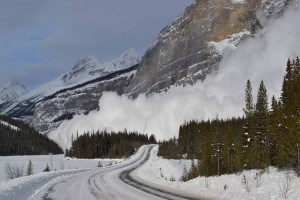
Parks Canada’s avalanche control team was out in full force earlier this week, dealing with precarious conditions brought on by the weekend’s bout of unseasonably warm weather.
According to Environment Canada, temperatures in Jasper reached 10°C Jan. 25, and remained high for days, with the mercury climbing to 8°C Jan. 27.
The warm air came courtesy of a “pineapple express” weather system that brought heaps of warm, moist air from Hawaii into the Rockies.
According to Rupert Wedgwood, a visitor safety specialist for Parks Canada, the result was more melting snow, which meant lots of melt water in the valley bottom destabilizing the snowpack. That pushed avalanche danger for the backcountry to “high” over the weekend, and lead to elevated hazard levels along Highway 93.
Wedgwood said that because of those elevated hazard levels Parks avalanche control teams were out both Jan. 25 and Jan. 27 along Highway 93 triggering controlled slides.
“We’ve got the whole crew out there doing avalanche control, both from the air and the ground,” he said in an interview Jan. 27.
Parks avalanche control specialists monitor avalanche conditions in the park on a daily basis, and when risks get too high they trigger avalanches by dropping explosives in high-risk areas to set off slides on their own terms.
Teams shut down Highway 93 to begin that work Jan. 25, but because of difficult conditions brought on by the storm, had to return Jan. 27 to finish the job.
Wedgwood explained that right now many of the mountain slopes contain snowpack that is in an “isothermal” state.
“Typically when people think of avalanches they think of these long, slab-like releases from high up in the alpine, and that generally [stems from] a dry snow condition. Those conditions do exist right now in the alpine, but what makes this unusual is that lower down, once you get below the freezing level, the snow turns to mush, or isothermal.”
Isothermal snow packs make clearing large tracts difficult because when teams lay the explosives they tend to result in “point release” avalanches, rather than the preferred “slab” avalanches.
Wedgwood explained that the idea behind avalanche control work is to trigger slides in a controlled environment before they happen randomly, potentially harming park users. “Slab” avalanches are large swaths of snow that break off in one piece, clearing a hazardous area in one go.
“Point releases,” however, don’t take large sections of snow with them. Instead, snow slides in a pyramid shape beneath the explosive, leaving the rest of the potential avalanche intact.
“So it’s very hard to get a full clean-out using explosives, and that’s the condition that we have on a couple of our paths right now.”
To deal with this problem, crews have to do what Wedgwood calls “shaking the rocks.”
“That’s putting in a very specific explosive which produces a large percussion.
“We have to drop a large bag of explosives close to a rock outcrop that hopefully will kind of shake the rock underlayer. That will cause [snow] to move over a much larger area, as opposed to just dropping explosives into a fat pillow of snow that will just produce a point release.”
That technique can be challenging, because crews dropping explosives from a helicopter have to get very close to the mountain for the precise placement—a difficult maneuver for the pilot.
Wedgwood said that this week’s work was successful, however, and teams accomplished most of what they wanted to, along with a little “spring cleaning” to make things easier later in the season.
Wedgwood said that until this weekend’s storm surge, this winter’s warmer-than-average weather hasn’t affected avalanche control too much. So far this season, teams have been out three times (including Jan. 25 and Jan. 27), and no member of the public has reported being involved in an avalanche.
Further, January’s warm weather should actually make control work much easier later in the season.
“Every storm system will leave a legacy behind it of a new layer. So the expectation is that with this warm weather we will now have a rain crust—which is a smooth surface—that once it freezes and gets some snow on top of it will be another sliding layer for later on in the winter,” Wedgwood said.
“It will mean that we will have a weak layer to work with, which is good, because we’ll just have to wait for the right amount of load on top of that weak layer, and then under the right conditions we’ll go out and trigger more avalanches using explosives.”
For now, Wedgwood cautioned park users to be aware of avalanche conditions. Danger in the backcountry remains “high”, and users can monitor conditions by checking Parks’ daily avalanche bulletin at avalanche.pc.gc.ca.
Road travellers can also check Alberta road reports at www.511.ab.ca, or get Jasper-specific information by calling 780-852-3311.
Trevor Nichols
[email protected]
